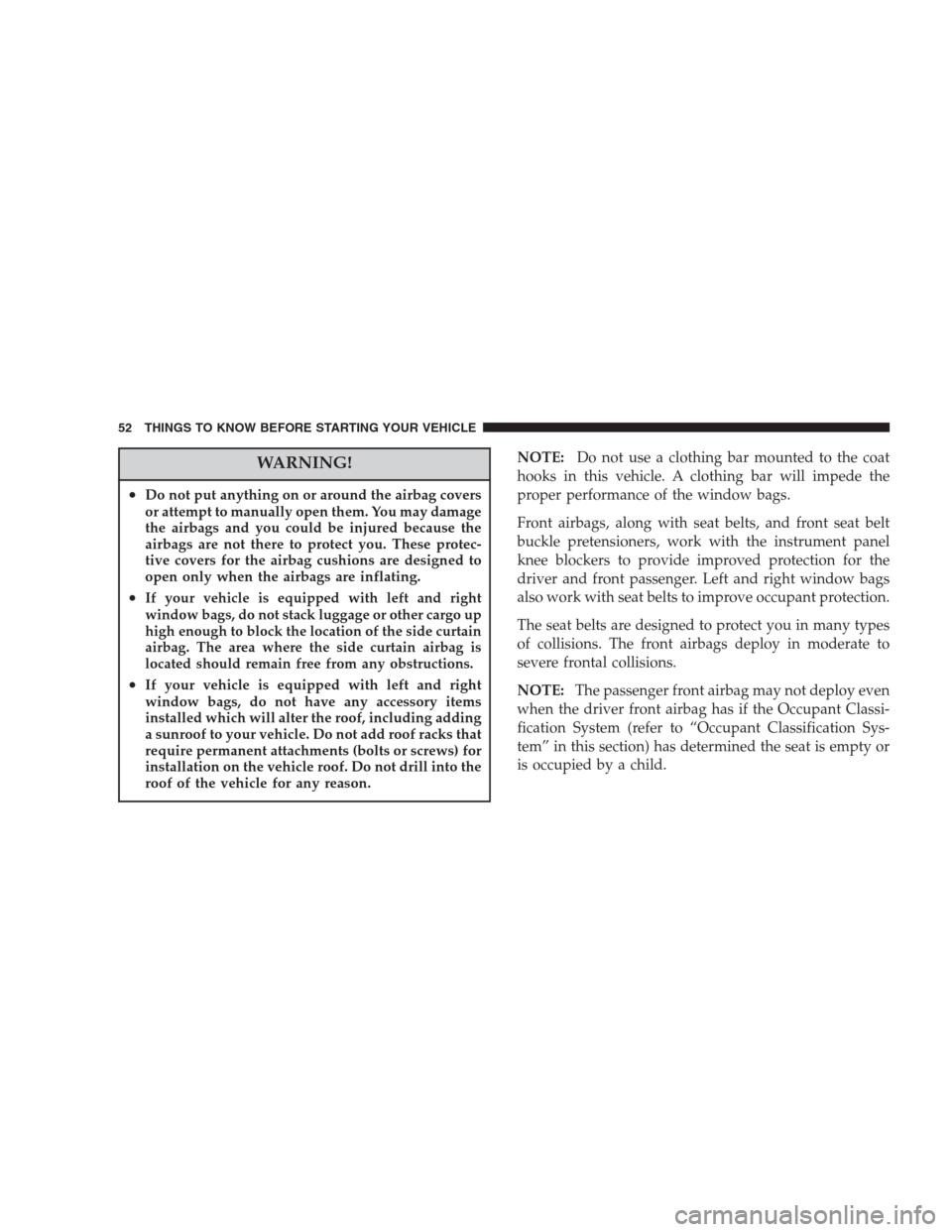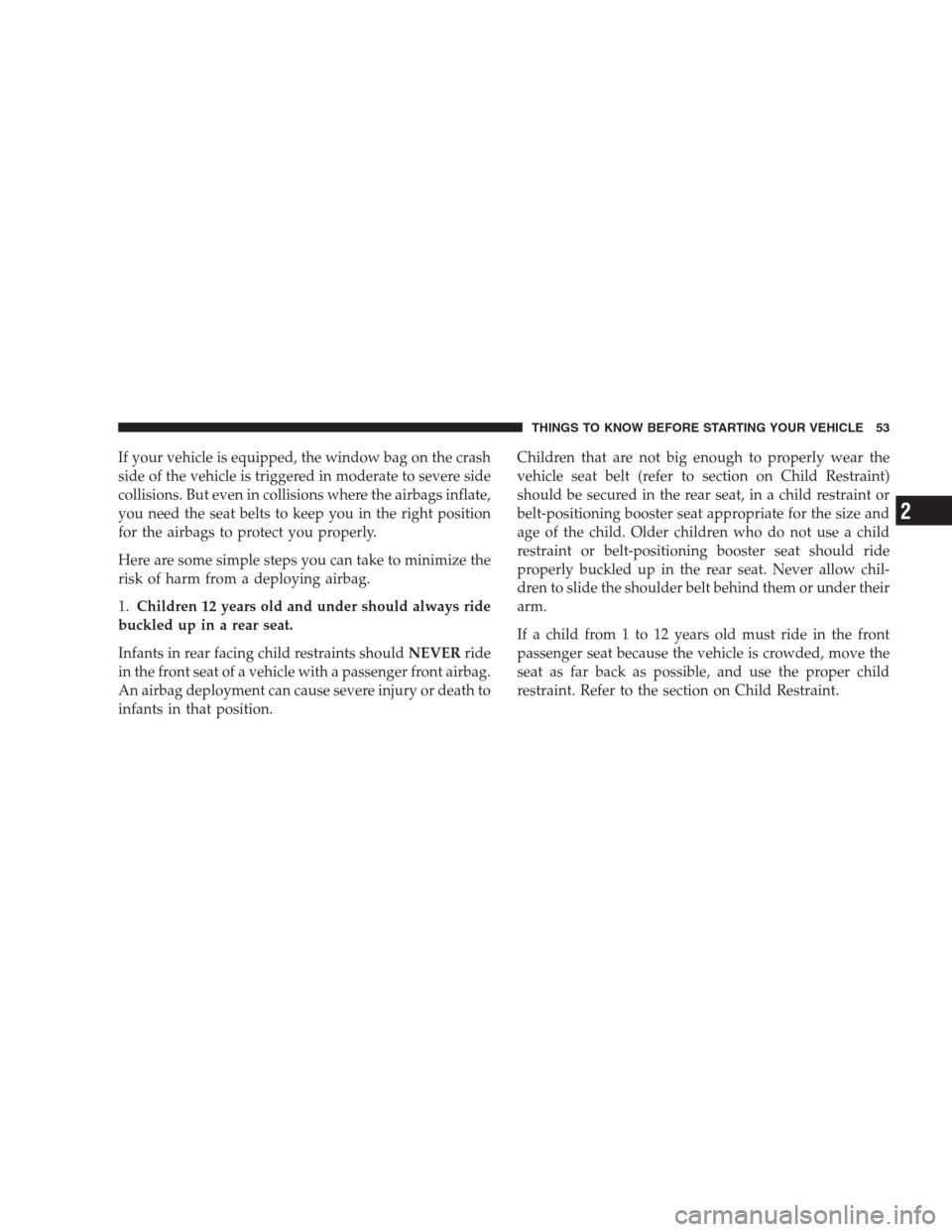Page 10 of 464

▫To Disarm The System...................19
▫Security System Manual Override...........19
�Illuminated Entry System..................20
�Remote Keyless Entry.....................20
▫To Unlock The Doors And Liftgate..........21
▫To Lock The Doors And Liftgate............22
▫To Open/Close Power Liftgate — If Equipped . .23
▫Flash Lights On Lock/Unlock.............23
▫Using The Panic Alarm..................24
▫Programming Additional Transmitters........25
▫Battery Replacement....................25
�Door Locks............................27
▫Manual Door Locks.....................27▫Power Door Locks.....................28
▫Child Protection Door Lock...............31
�Windows.............................33
▫Power Windows.......................33
�Liftgate...............................35
▫Power Liftgate — If Equipped.............37
�Occupant Restraints......................40
▫Lap/Shoulder Belts.....................41
▫Lap/Shoulder Belt Untwisting Procedure.....47
▫Seat Belt Pretensioners...................47
▫Enhanced Seat Belt Use Reminder System
(BeltAlert) — Driver Front Seat Only........48
▫Seat Belts And Pregnant Women............49
10 THINGS TO KNOW BEFORE STARTING YOUR VEHICLE
Page 11 of 464
▫Seat Belt Extender......................49
▫Driver And Front Passenger Supplemental
Restraint System - Airbag................50
▫Event Data Recorder (EDR)...............65
▫Child Restraint........................67
�Engine Break-In Recommendations...........79�Safety Tips............................79
▫Exhaust Gas..........................79
▫Safety Checks You Should Make Inside
The Vehicle..........................80
▫Periodic Safety Checks You Should Make
Outside The Vehicle....................81
THINGS TO KNOW BEFORE STARTING YOUR VEHICLE 11
2
Page 31 of 464
Child Protection Door Lock
To provide a safer environment for small children riding
in the rear seats, the rear doors are equipped with a child
protection door lock system.
NOTE:When the child lock system is engaged, the door
can be opened only by using the outside door handle
even though the inside door lock is in the unlocked
position.
To Engage the Child Protection Door Lock
1. Open the rear door.
2. Insert the tip of the vehicle’s ignition key (or any
similar item) into the child lock control and slide it
upward.3. Repeat Steps 1 and 2 to engage the Child Protection
Door Lock on the opposite rear door.
NOTE:After engaging the child protection door lock
system, always test the door from the inside to make
certain it is in the desired position.
Child Lock Control
THINGS TO KNOW BEFORE STARTING YOUR VEHICLE 31
2
Page 40 of 464
OCCUPANT RESTRAINTS
Some of the most important safety features in your
vehicle are the restraint systems. These include the front
and rear seat belts for the driver and all passengers, front
airbags for both the driver and front passenger, and if
equipped, left and right window bags for the driver and
passengers seated next to a window and a driver inflat-
able knee blocker. If you will be carrying children too
small for adult-size seat belts, your seat belts or the
LATCH feature (refer to the Child Restraint section in this
manual), can be used to hold infant and child restraint
systems.
NOTE:The front airbags have a multi stage inflator
design. This allows the airbag to have different rates of
inflation that are based on collision severity.
Passenger Airbag Disabled Light
40 THINGS TO KNOW BEFORE STARTING YOUR VEHICLE
Page 52 of 464

WARNING!
•Do not put anything on or around the airbag covers
or attempt to manually open them. You may damage
the airbags and you could be injured because the
airbags are not there to protect you. These protec-
tive covers for the airbag cushions are designed to
open only when the airbags are inflating.
•If your vehicle is equipped with left and right
window bags, do not stack luggage or other cargo up
high enough to block the location of the side curtain
airbag. The area where the side curtain airbag is
located should remain free from any obstructions.
•If your vehicle is equipped with left and right
window bags, do not have any accessory items
installed which will alter the roof, including adding
a sunroof to your vehicle. Do not add roof racks that
require permanent attachments (bolts or screws) for
installation on the vehicle roof. Do not drill into the
roof of the vehicle for any reason.
NOTE:Do not use a clothing bar mounted to the coat
hooks in this vehicle. A clothing bar will impede the
proper performance of the window bags.
Front airbags, along with seat belts, and front seat belt
buckle pretensioners, work with the instrument panel
knee blockers to provide improved protection for the
driver and front passenger. Left and right window bags
also work with seat belts to improve occupant protection.
The seat belts are designed to protect you in many types
of collisions. The front airbags deploy in moderate to
severe frontal collisions.
NOTE:The passenger front airbag may not deploy even
when the driver front airbag has if the Occupant Classi-
fication System (refer to “Occupant Classification Sys-
tem” in this section) has determined the seat is empty or
is occupied by a child.
52 THINGS TO KNOW BEFORE STARTING YOUR VEHICLE
Page 53 of 464

If your vehicle is equipped, the window bag on the crash
side of the vehicle is triggered in moderate to severe side
collisions. But even in collisions where the airbags inflate,
you need the seat belts to keep you in the right position
for the airbags to protect you properly.
Here are some simple steps you can take to minimize the
risk of harm from a deploying airbag.
1.Children 12 years old and under should always ride
buckled up in a rear seat.
Infants in rear facing child restraints shouldNEVERride
in the front seat of a vehicle with a passenger front airbag.
An airbag deployment can cause severe injury or death to
infants in that position.Children that are not big enough to properly wear the
vehicle seat belt (refer to section on Child Restraint)
should be secured in the rear seat, in a child restraint or
belt-positioning booster seat appropriate for the size and
age of the child. Older children who do not use a child
restraint or belt-positioning booster seat should ride
properly buckled up in the rear seat. Never allow chil-
dren to slide the shoulder belt behind them or under their
arm.
If a child from 1 to 12 years old must ride in the front
passenger seat because the vehicle is crowded, move the
seat as far back as possible, and use the proper child
restraint. Refer to the section on Child Restraint.
THINGS TO KNOW BEFORE STARTING YOUR VEHICLE 53
2
Page 54 of 464

You should read the instructions provided with your
child restraint to make sure that you are using it properly.
2.All occupants should wear their lap and shoulder
belts properly.
3.The driver and front passenger seats should be
moved back as far as practical to allow the front airbags
room to inflate.
4.If your vehicle has left and right window bags, do
not lean against the door, airbags will inflate forcefully
into the space between you and the door.WARNING!
•Relying on the airbags alone could lead to more
severe injuries in a collision. The airbags work
with your seat belt to restrain you properly. In
some collisions the airbags won’t deploy at all.
Always wear your seat belts even though you
have airbags.
•Being too close to the steering wheel or instru-
ment panel during front airbag deployment could
cause serious injury. Airbags need room to inflate.
Sit back, comfortably extending your arms to
reach the steering wheel or instrument panel.
•If the vehicle has left and right window bags, they
also need room to inflate. Do not lean against the
door or window. Sit upright in the center of the
seat.
54 THINGS TO KNOW BEFORE STARTING YOUR VEHICLE
Page 58 of 464

about 30 milliseconds (about one quarter of the time it
takes to blink your eyes) with enough force to injure
you if you are not belted and seated properly, or if
items are positioned in the area where the window bag
inflates. This especially applies to children. The win-
dow bag is only about 3
1�2inches (9 cm) thick when it
is inflated.
•When the ORC and the impact sensors detect a
collision requiring theDriver Inflatable Knee
Blocker,it signals the inflator unit. A quantity of
nontoxic gas is generated to inflate the Driver Inflat-
able Knee Blocker. The Driver Inflatable Knee Blocker
inflates rearward towards the driver’s knees to help
protect the knees and position you for the best inter-
action with the front airbag. The Driver Inflatable
Knee Blocker fully inflates in about 50 milliseconds,
this is only about half of the time it takes you to blink
your eyes. It then quickly deflates while helping to
protect the driver’s knees.
•TheKnee Impact Bolstershelp protect the knees, and
position everyone for the best interaction with the
front airbag.
•If your vehicle contains a Passenger Airbag Disable
indicator light, it will be equipped with theOccupant
Classification System (OCS).The OCS system will
classify an occupant into a size category based on
sensor readings from within the seat cushion. Occu-
pants should try to remain in a normally seated
position. If the occupant’s weight is transferred to
another object in the vehicle (i.e. feet on the dash-
board), the OCS may not be able to properly approxi-
mate occupant size. Furthermore, the occupant size
may appear to increase or decrease due to objects
hanging on the seat, other passengers pushing on the
seat, or objects lodged underneath the seat.
58 THINGS TO KNOW BEFORE STARTING YOUR VEHICLE